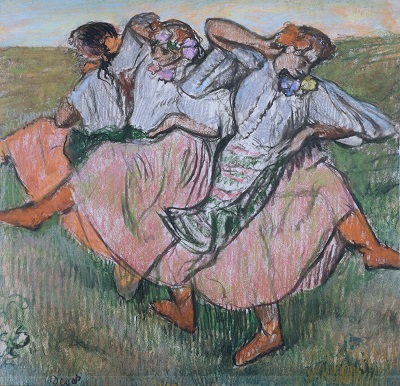
from Amazon
* As an Amazon Associate, and partner with Google Adsense and Ezoic, I earn from qualifying purchases.
Created in 1899, the pastel impressionism piece manifests a different culture compared to the artist’s classic French paintings. Russian Dancers illustrates the foreign movement of a dominating culture showcasing their transitions through the art of dance.
Along with the artist lust for liberating the female body bathing and the art of ballet, Degas created a few pieces that promoted foreign woman dancing. The vibrant tones and dynamic shapes cover the painting in a pleasant style. Edgar Degas has constructed such a methodical piece that the sounds of the music to which the women dance to alludes from the canvas. The painting showcases 3 women dressed is Russian dresses dancing as they lift left legs. Their skills swirl as they lift their arms and ruffle their voluminous fabrics. The artist was beautifully able to create a rich movement through their bodily actions in harmony to one another.
The artwork belongs to an array of projects Edgar Degas painted paying tribute to the culture of Ukrainian and Russian dancing. This portfolio of Eastern European dance came prior to Degas’s captivation with ballet. Art historians believe that the artist had witnessed this foreign culture in Paris where he attended a Russian performance. These foreign performances gained much popularity in Paris where the rich would flock to witness beautiful exotic cultures as travel was limited. While it has been proven that these women are in fact Ukrainian dancers, the painting remains titled Russian Dancers as they held a similar culture. The artwork proves that Degas was in fact seized by the female presence as it swirls in musical harmony. These prominent women illustrate this association as they are captivated in a trance by their cultural dance.
These three women horizontally fill the canvas next to one another in rich pastel colours. The first woman to the right is dressed in a loose white blouse and a lilac lavender skirt. The beautiful shade of her skirt fills the painting with warmth and emotion. The woman is dressed in blood red boots beneath her dress with a red cloth around her waist. These rich red colours that accentuate the woman’s attire are the most favoured of Eastern European cultures. At the time these cultures praised the colour red in which they derived from the Alder tree. This rich red colour is used to create a red ruffled necklace around the woman’s neck. The other woman next to her is dressed in the similar attire, however her skirt is painted in a deep royal blue. The last woman on the left copies the other two women’s outfits, however has a skirt coloured in a teal green.
The scene most likely depicts the traditional Ukrainian sun honouring dance. These women have beautifully accessorize themselves through weaving flower crowns placed upon their head while they dance in tribute. The warm painting is set on a hilly meadow where they dance together as one entity. The grass beneath them is coloured in verticals strokes in a multitude of different tones. Shades of yellow populate most of the grass with hints of green, blue, and light pink. The background of the scene breaks into hilly mountains covered in shades of green and brown. The sunset in the sky mixes warm tones of yellow, orange, and pink together, creating a sensual atmospheric presence.
As Degas showcases shades of green and blue within the painting, he still creates a warm tone through the use of a sunset in the sky rather than a classic cloudless blue. The artist has achieved these rich shades within the pieces by continuously layering pastels upon one another. He would alter the contours and shapes within the piece through each new layer of colour to add depth to his work. These colours add an immense vibrancy to the piece, similarly showcased within his other work Four Dancers and Blue Dancers.